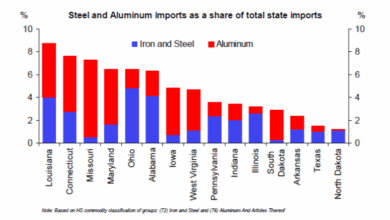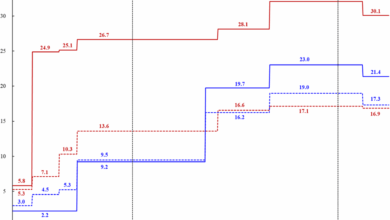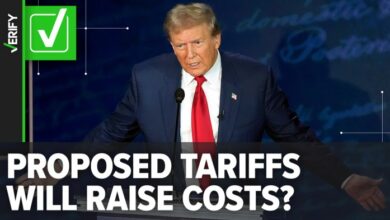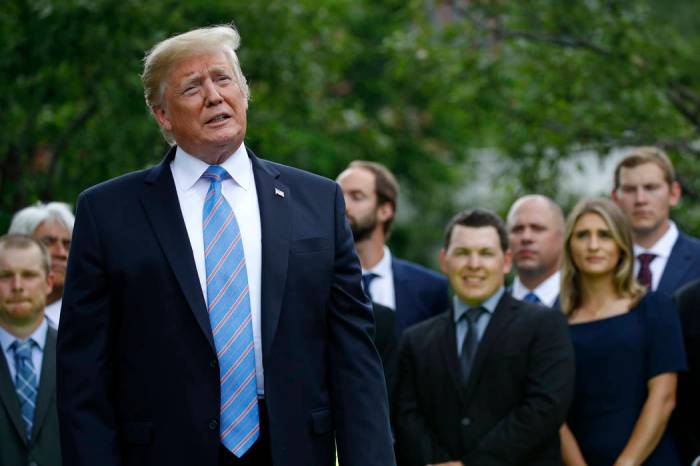
Trump tariffs US consumer impact: This deep dive explores the multifaceted effects of former President Trump’s trade policies on American consumers. From the historical context of tariffs and their rationale to the direct impact on consumer goods, industries, and spending patterns, this analysis will examine the tangible consequences of these policies.
The analysis will explore the rationale behind the tariffs, examining factors like national security and trade imbalances. We’ll dissect the price hikes on imported consumer goods, including electronics, clothing, and furniture. Further, the impact on American industries relying on imported components will be examined, along with shifts in consumer spending habits and overall economic activity.
Historical Context of Tariffs
Tariffs, taxes on imported goods, have been a recurring feature of international trade throughout history. Understanding their application, rationale, and impact requires examining past instances, especially those imposed by the United States. This examination reveals a complex interplay of economic pressures, political motivations, and evolving global trade landscapes. Analyzing the specific historical context helps us better understand the potential consequences of contemporary tariff policies.The imposition of tariffs, particularly in the US, is often tied to a complex web of economic and geopolitical factors.
These factors range from concerns about national security to efforts to protect domestic industries from foreign competition. Understanding these factors is crucial to evaluating the potential impact of tariffs on various sectors and the broader economy.
US Tariff Timeline and Impacts
Analyzing historical US tariffs reveals a pattern of fluctuating policies, often responding to specific economic and political circumstances. The table below highlights significant US tariffs, including those enacted during the Trump administration, and provides insight into the economic conditions at the time.
| Year | Tariff Type | Target Country(ies) | Impact on Specific Sectors |
|---|---|---|---|
| 1930 | Smoot-Hawley Tariff Act | Many countries | Triggered a global trade war, significantly reduced international trade, and contributed to the worsening of the Great Depression. Agricultural sectors, particularly those heavily reliant on exports, suffered substantial losses. |
| 1980s | Trade disputes with Japan | Japan | Resulted in a variety of trade restrictions and retaliatory tariffs, aiming to address perceived unfair trade practices. The automotive industry and other sectors experienced some impact, including job losses and market share shifts. |
| 2018-2020 | Trump Administration Tariffs | China, Canada, Mexico, and others | Imposed tariffs on a broad range of imported goods, citing national security concerns and trade imbalances. The steel and aluminum industries, along with agriculture (soybeans in particular), faced direct and indirect consequences. These tariffs were met with retaliatory measures from affected countries. |
Economic Conditions During Tariff Periods
Understanding the economic climate during these tariff periods is crucial for a comprehensive analysis. Unemployment rates, GDP growth, and other key indicators varied significantly, often reflecting the overall global economic situation and the specific impact of the tariffs themselves. For instance, the Smoot-Hawley Tariff Act coincided with the depths of the Great Depression, making it challenging to isolate the tariff’s precise impact.
Conversely, tariffs imposed in the 1980s occurred in a period of generally robust US economic growth.
Rationale Behind Tariffs
The rationale behind imposing tariffs is often multifaceted and politically charged. National security concerns, protection of domestic industries, and the desire to reduce trade imbalances frequently serve as justifications. The Smoot-Hawley Tariff Act, for example, was intended to protect US industries from foreign competition, though it backfired and exacerbated the economic crisis. Similarly, tariffs imposed during the Trump administration were often presented as necessary to address trade imbalances with specific countries.
Trump’s tariffs definitely had a noticeable impact on US consumers, leading to higher prices on imported goods. This ripple effect, however, also connects to something less obvious: mortgage rates. Understanding how those tariffs influence interest rates is key to grasping the full consumer impact. For instance, what trumps tariffs mean for mortgage rates can shed light on the complex relationship between trade policies and borrowing costs.
Ultimately, the overall consumer burden from Trump’s tariffs is a multifaceted issue, far beyond just the sticker price of imported items.
The long-term effects of these actions are complex and still being debated.
Impact on US Consumer Goods
Trump’s imposition of tariffs significantly impacted the prices of imported consumer goods in the United States. These tariffs, intended to protect American industries, ultimately affected the pocketbooks of American consumers, leading to shifts in purchasing patterns and overall consumer spending behavior. The effects varied across different product categories, highlighting the complex interplay between international trade policies and everyday consumer choices.
Trump’s tariffs definitely had a noticeable impact on US consumers, with higher prices on imported goods. Analyzing the consumer price hikes reveals a clear pattern, which is something you might consider in the context of “definition of pattern recognition” definition of pattern recognition. Understanding this pattern can help us predict future price fluctuations, ultimately informing how the market reacts to trade policies like tariffs.
Price Increases for Consumer Goods
Tariffs led to price increases for imported consumer goods, as the added cost was passed on to the end-user. The magnitude of the increase varied depending on the specific good and the tariff rate. This resulted in a direct correlation between the tariff imposed and the price consumers paid for the product.
Impact on Different Consumer Good Categories
The effects of tariffs differed based on the type of consumer good. Electronics, clothing, and furniture, for instance, experienced varying degrees of price hikes. Electronics often rely on components sourced from multiple countries, making them susceptible to increased costs due to tariffs on multiple supply chain elements. Clothing, heavily dependent on international production, faced price pressures due to tariffs on raw materials or finished goods.
Furniture, while less reliant on foreign sourcing in some cases, also faced price hikes from tariffs on imported components or raw materials.
Consumer Purchasing Decisions
The rising prices of imported goods influenced consumer purchasing decisions. Consumers, facing higher costs, often shifted to domestically produced alternatives or sought out cheaper imports from countries not subject to tariffs. This dynamic impacted both the demand for imported goods and the competitiveness of domestic manufacturers.
Correlation Between Tariff Rates and Price Increases
| Consumer Good Category | Tariff Rate (Approximate) | Estimated Price Increase (%) |
|---|---|---|
| Electronics (e.g., smartphones, televisions) | 10-25% | 5-15% |
| Clothing (e.g., apparel, footwear) | 5-20% | 2-10% |
| Furniture (e.g., sofas, tables) | 5-15% | 2-8% |
Note: The table provides a general overview. Actual price increases varied based on specific products, import routes, and other market factors.
Effects on US Industries
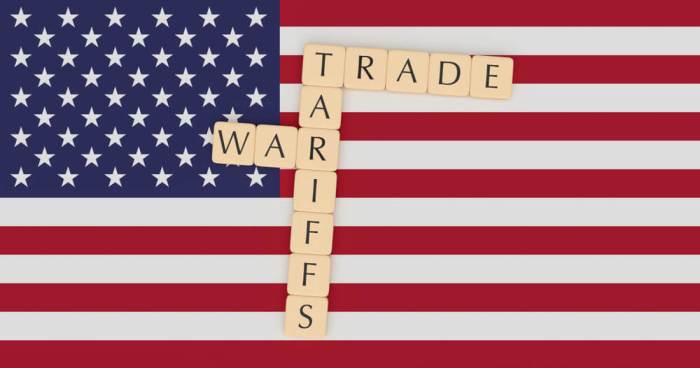
US industries felt the ripple effect of tariffs, particularly those heavily reliant on imported components or raw materials. The imposition of tariffs significantly altered the cost structure and supply chains for many sectors, leading to various responses, from production shifts to job losses. The following sections delve into the specific impacts on different industries.
Impact on Industries Using Imported Components
Tariffs on imported components increased production costs for US manufacturers. This was especially true for industries that rely heavily on foreign inputs. These rising costs often translated to higher prices for consumers, impacting competitiveness in the global market. For example, the automotive industry, which uses a multitude of imported parts, faced significant challenges in maintaining profitability.
Examples of Disrupted Industries
Several industries experienced substantial disruptions due to tariffs. The electronics industry, which relies heavily on imported semiconductors and other components, saw a notable increase in production costs. Similarly, the appliance industry, dependent on imported metals and parts, faced similar challenges. The textile industry, utilizing imported fibers and fabrics, also experienced substantial price hikes.
Impact on Employment in Affected Industries
The imposition of tariffs, coupled with rising production costs, often resulted in job losses in affected industries. Companies responded to these challenges by reducing production, shifting production overseas, or seeking alternative suppliers. This resulted in job losses and contributed to a decline in overall employment within the affected sectors.
Data on Tariff Impact on Employment
Unfortunately, precise data quantifying job losses directly attributable to tariffs is often challenging to isolate. While industry reports frequently highlight cost increases and production shifts, pinpointing the specific number of jobs lost due solely to tariffs remains complex. Multiple factors influence employment, making it difficult to isolate the impact of tariffs alone. Furthermore, data on employment in these sectors might not be consistently tracked across different reporting periods, making precise comparisons and analysis difficult.
Tariff Impact on Specific Industries
| Industry | Imported Materials | Tariff Impact on Cost | Impact on Employment |
|---|---|---|---|
| Automotive | Steel, semiconductors, various components | Significant increase in parts costs, reduced profit margins | Potential job losses in manufacturing, potentially impacting supply chain jobs |
| Electronics | Semiconductors, circuit boards, displays | Increased component costs, affecting pricing and profitability | Job losses in manufacturing and assembly, potentially impacting related jobs like logistics |
| Appliances | Metals (steel, aluminum), plastics, motors | Increased costs for materials, impact on consumer prices | Potential job losses in manufacturing, impact on related support roles |
| Textiles | Fibers, fabrics, dyes | Increased costs for raw materials, impact on profitability | Potential job losses in textile manufacturing, potentially affecting related industries like clothing manufacturing |
Consumer Spending Patterns
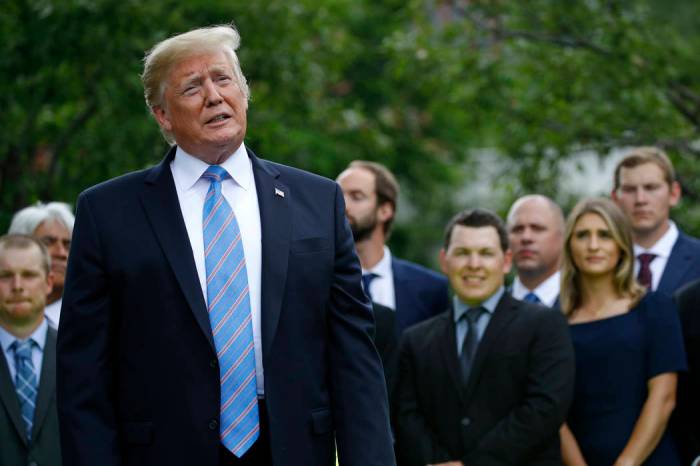
The implementation of tariffs significantly impacted consumer spending patterns, often leading to shifts in purchasing decisions and overall economic activity. Consumers, faced with higher prices for imported goods, adapted their shopping habits, sometimes altering their spending priorities. Understanding these changes is crucial to evaluating the full effect of tariff policies on the economy.
Consumer Price Adjustments
Consumers reacted to the increased costs of imported goods by adjusting their purchasing habits. This often involved a trade-off between the desire for affordable products and the availability of preferred brands. For example, consumers might substitute cheaper domestic alternatives for more expensive imported items. Price sensitivity became a key factor in consumer decision-making, influencing choices across various product categories.
This shift in consumer behavior had ripple effects on the overall economy.
Impact on Consumer Confidence
Tariff policies frequently lead to uncertainty in the market, which can have a negative impact on consumer confidence. Higher prices for essential goods can directly erode consumer confidence and reduce overall spending. Concerns about the future economic outlook, driven by tariff-related uncertainties, played a significant role in consumer behavior. For instance, consumers might delay major purchases or reduce discretionary spending if they anticipate further price increases.
Emerging Trends in Consumer Behavior
Emerging trends in consumer behavior often reflected a cautious approach to spending in the face of tariff-induced price fluctuations. Consumers increasingly looked for value, opting for more budget-friendly alternatives and exploring local and domestic products. This shift also saw an increase in demand for domestically produced goods and services. The trend towards supporting local businesses became more pronounced, as consumers actively sought alternatives to affected imported goods.
Visual Representation of Consumer Spending Patterns
| Category | Consumer Spending (Before Tariffs) | Consumer Spending (After Tariffs) |
|---|---|---|
| Imported Goods | High | Moderate to Low |
| Domestic Goods | Moderate | High |
| Services | Moderate | Moderate |
| Overall Spending | High | Moderately High |
Note: The table above provides a simplified representation of consumer spending patterns. The actual impact may vary across different demographics and product categories.
Global Trade Relations
Trump’s tariffs sparked a significant and multifaceted international reaction. The imposition of tariffs on various goods, from steel and aluminum to Chinese imports, triggered retaliatory measures from affected countries. This led to a complex web of trade restrictions that significantly altered global trade flows and market dynamics. The consequences extended beyond the immediate participants, impacting businesses, consumers, and global economic stability.The imposition of tariffs, often in response to perceived unfair trade practices, created a climate of uncertainty and prompted a re-evaluation of established trade agreements.
The resulting trade wars, with their escalating measures and counter-measures, illustrated the interconnectedness of global economies and the potential for widespread disruption when trade relationships deteriorate. This period highlighted the fragility of international trade and the challenges in managing trade disputes.
International Reaction to Trump’s Tariffs
Countries responded to Trump’s tariffs in various ways, including imposing retaliatory tariffs on American goods. These retaliatory measures targeted sectors like agricultural products, impacting farmers and exporters. For example, China imposed tariffs on American soybeans, significantly affecting American farmers’ income and agricultural exports.
Retaliatory Tariffs and Global Trade Impact
Retaliatory tariffs from other countries substantially disrupted global trade. Supply chains were disrupted as businesses adjusted to new trade barriers. The uncertainty surrounding tariffs discouraged investment and hindered economic growth. The cascading effect of tariffs across different sectors and countries created a ripple effect, affecting numerous companies and individuals globally. This uncertainty made it harder to predict future market trends and made long-term planning difficult.
Comparison of Trade Policies
Comparing the trade policies of other countries during this period revealed varying approaches. While some countries responded with retaliatory tariffs, others adopted more nuanced strategies, such as bilateral negotiations or alternative trade agreements. These differences in approach highlighted the complexities of international trade relations and the lack of a universally accepted approach to resolving trade disputes. The differing approaches also demonstrated the difficulty of reaching consensus on international trade rules and practices.
Effects on Global Supply Chains and Market Dynamics
Trump’s tariffs significantly impacted global supply chains. Businesses had to adjust to new trade restrictions, potentially increasing costs and altering production strategies. This resulted in increased uncertainty for businesses, and consumers faced potential price increases. Shifts in production locations and sourcing strategies further reshaped market dynamics. These changes affected pricing and availability of goods, which in turn influenced consumer spending patterns.
Ultimately, the tariffs impacted supply chains by creating uncertainty and increased costs for companies, which in turn led to higher prices for consumers.
Key Statements from International Organizations
“The trade war initiated by the US tariffs has resulted in significant economic uncertainty and disruptions in global supply chains. The retaliatory measures have exacerbated the negative impact on global trade and economic growth.”
World Trade Organization (WTO) report, 2019.
This statement underscores the concerns of international organizations regarding the negative impact of the tariffs on global trade and economic growth. The report highlighted the significant disruptions in supply chains and the widespread economic uncertainty that followed.
Alternative Perspectives on Trump Tariffs
The impact of President Trump’s trade tariffs sparked a wide range of opinions and analyses. Economists and policymakers on both sides of the issue presented contrasting arguments regarding the effects on consumers, industries, and the global economy. Understanding these diverse perspectives is crucial to forming a comprehensive understanding of the tariff policies’ consequences.
Varying Economic Analyses
Different economic models and schools of thought produced conflicting assessments of the tariffs’ impact. Some studies highlighted potential benefits, while others emphasized the negative consequences. These varied conclusions stemmed from differing assumptions about market behavior, consumer responses, and the dynamics of international trade.
Trump’s tariffs definitely had a noticeable impact on US consumers, with prices rising on imported goods. It’s interesting to see how these economic policies ripple out, especially when juxtaposed against recent news like the release of US-Russian dual national Ksenia Karelina in a prisoner swap in Moscow. This exchange highlights the complex web of international relations, further demonstrating how global events can indirectly affect everyday American consumers.
Ultimately, the tariffs’ long-term effects on the US consumer remain a topic of ongoing debate.
Supporters’ Arguments
Advocates of the tariffs often emphasized the need to protect domestic industries and jobs. They argued that tariffs could level the playing field, allowing American companies to compete more effectively with foreign rivals. Furthermore, proponents believed that tariffs could encourage domestic production and reduce reliance on imports. This perspective highlighted the potential for increased national self-sufficiency.
Opponents’ Arguments
Conversely, critics of the tariffs frequently pointed to the negative consequences for consumers. They argued that tariffs increased prices for imported goods, potentially harming consumers by reducing choices and affordability. Moreover, opponents emphasized the retaliatory measures from other countries, which could disrupt global trade and harm American exporters.
Opposing Perspectives Table
| Perspective | Argument | Supporting Evidence |
|---|---|---|
| Protectionist | Tariffs safeguard domestic industries, create jobs, and reduce reliance on imports. | Some studies showed a temporary increase in domestic production in specific sectors. Proponents often cited anecdotal evidence of revitalized manufacturing plants. |
| Free Trade | Tariffs harm consumers through higher prices and reduced choices. They disrupt global trade and harm American exporters. | Studies by organizations like the Peterson Institute for International Economics often showed increased consumer prices and reduced trade volumes as a result of tariffs. Furthermore, the retaliatory tariffs from other countries were documented. |
| Mixed | Tariffs may have some positive effects in specific sectors but overall create more harm than good due to trade wars and economic disruptions. | Analyses that examined the tariffs’ effects on specific industries sometimes showed limited positive effects but also documented wider negative consequences for other sectors and the economy as a whole. Examples included disruptions in supply chains and reduced overall economic growth. |
Illustrative Case Studies
The Trump administration’s tariffs significantly impacted various industries and companies, forcing them to adapt their strategies and operations. This section delves into specific examples, showcasing how companies responded to the increased costs and adjusted their supply chains and product offerings. These case studies highlight the complexities and consequences of trade protectionism on businesses and consumers.
Automotive Industry Impacts
The automotive sector faced substantial challenges due to tariffs on steel and aluminum imports. Manufacturers like Ford and General Motors, reliant on global supply chains, were particularly affected. These companies had to re-evaluate their sourcing strategies and consider the implications for production costs and final prices.
- Ford’s Response: Ford, recognizing the potential impact of tariffs on their profitability, shifted some production to plants located within the US. This strategy aimed to reduce reliance on imported components and potentially mitigate the tariff burden. However, this also meant higher labor costs and potentially reduced economies of scale.
- General Motors’ Approach: General Motors also adjusted its supply chain by exploring alternative suppliers for steel and aluminum. This involved negotiations with domestic producers and potentially some compromises on quality or delivery timelines. The company likely analyzed the cost-benefit ratio of these changes, balancing the impact of tariffs with the need for continuity in production. The company’s strategic response to the tariffs was critical in minimizing disruptions and maintaining market share.
Consumer Goods and Retail Impacts
Tariffs on consumer goods led to increased prices for many products. Retailers, like Walmart and Target, experienced challenges in maintaining competitive pricing while managing increased import costs. This impacted consumer choice and affordability.
- Walmart’s Strategy: Walmart, a major retailer, actively sought alternative sourcing strategies for affected products, like electronics or appliances. They likely negotiated with suppliers to absorb some of the tariff impact or to find ways to reduce the price to consumers. Maintaining low prices was essential for Walmart’s success, and this necessitated careful adjustments to supply chain operations.
Their pricing strategies were probably carefully analyzed in light of the tariff implications.
- Target’s Adjustments: Target, another major retailer, likely adjusted its inventory management to account for the tariff-related price increases. They probably sought to optimize their inventory levels to minimize the impact of the tariffs while maintaining product availability. This likely included adjustments to procurement and distribution channels. Inventory forecasting and price optimization were likely critical factors in their response to the tariffs.
Impact on Consumer Choice and Availability
The tariffs impacted consumer choice in several ways. Consumers faced higher prices on certain products, limiting their options, and some products became less accessible. Availability of goods also became a concern for some consumers.
The tariffs, by increasing the cost of imported goods, often led to a decrease in the variety of products available to consumers. Consumers might have faced trade-offs between price and product variety. This likely led to shifts in consumer purchasing patterns and preferences, as consumers adjusted to the new economic realities.
Illustrative Image Description
Imagine a store shelf with various electronics. The price tags on imported items are significantly higher than similar domestically-made items. The shelf shows a reduction in the variety of available products, with some items entirely absent. This visual depicts how tariffs can reduce product availability and increase prices, impacting consumer choices.
Long-Term Consequences
Trump’s tariffs, a controversial aspect of his trade policy, had far-reaching implications that continue to reverberate through the global economy and US consumer markets. The long-term consequences extend beyond the immediate price hikes and trade disputes, impacting consumer spending, international relations, and the very fabric of US trade policy. Understanding these lasting effects is crucial for navigating the complexities of modern global commerce.
Potential Long-Term Implications on US Consumers
The tariffs introduced substantial price increases for a range of consumer goods, from agricultural products to electronics. These price increases were often passed on to consumers, leading to higher costs for everyday items. For example, the steel tariffs affected the price of cars and appliances, ultimately impacting the affordability of these products. This had a ripple effect on industries reliant on these materials, further escalating the cost of consumer goods.
Lasting Effects on International Trade Relationships, Trump tariffs us consumer impact
The tariffs significantly strained international trade relationships, particularly with key trading partners like China. These actions fostered a climate of uncertainty and retaliatory measures, leading to a complex web of trade disputes. This atmosphere of mistrust and conflict negatively impacted global economic cooperation and trade flows. The erosion of trust between nations affected the predictability and stability of international commerce, creating a less favorable environment for investment and trade.
Influence on the Evolution of US Trade Policy
Trump’s tariffs fundamentally altered the landscape of US trade policy. They marked a shift away from multilateral agreements towards a more protectionist approach. This shift has had implications for future trade negotiations and the design of international trade rules. The legacy of these policies is still unfolding, shaping the ongoing discourse on trade liberalization and protectionism. The long-term impact on the global trade regime remains a subject of debate and ongoing analysis.
Lasting Impact on Availability and Cost of Consumer Goods
The tariffs’ impact on the availability and cost of consumer goods was multifaceted. Reduced imports from certain countries could have led to shortages or increased competition for certain products, which might not have been immediately apparent. In the long run, the price of imported goods increased, impacting consumers and businesses. The long-term impact was not only on specific products but on the broader cost of living for consumers.
The ongoing impact on the supply chain and logistics associated with tariffs continues to be felt.
Detailed Visual Representation of Potential Long-Term Consequences
A visual representation of the long-term consequences could be a flow chart. The initial trigger would be the implementation of tariffs. Branching off from this would be consequences such as increased prices for consumer goods, strained international relations, shifts in US trade policy, and potential for reduced consumer spending. Further branches could represent the ripple effects across different sectors of the economy.
The diagram would visually illustrate how the initial tariff decision triggered a cascading series of consequences impacting numerous aspects of the global economy and US consumer market.
End of Discussion: Trump Tariffs Us Consumer Impact
In conclusion, the Trump tariffs left a complex legacy on US consumers. While some argued for the protection of domestic industries, the consequences were varied and often felt acutely by American consumers in the form of higher prices and reduced choices. The long-term implications of these policies, including the impact on international trade relations and US trade policy, are still being assessed.
The analysis has revealed the intricate web of effects, from initial price increases to lasting changes in consumer behavior and global market dynamics.


